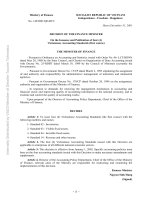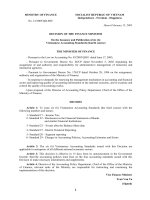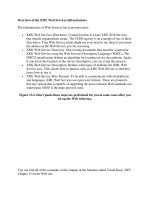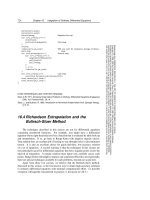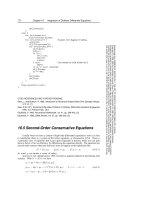Tài liệu Challenges of water resources management for downstream livelihood of the lower Mekong delta, VietNam pdf
Bạn đang xem bản rút gọn của tài liệu. Xem và tải ngay bản đầy đủ của tài liệu tại đây (86.77 KB, 7 trang )
1
CHALLENGES OF WATER RESOURCES MANAGEMENT FOR DOWNSTREAM
LIVELIHOOD OF THE LOWER MEKONG DELTA, VIETNAM
Tran Thi Trieu
1*
,
Le Anh Tuan
1**
, Mira Kakonen
2
1
Department of Environmental and Water Resources Engineering (DEWRE)
College of Technology (CoT), Can Tho Unversity (CTU)
Campus II, 3/2 street, Can Tho City, Vietnam
Corresponding e-mail: * , **
2
Water Resources Laboratory, Helsinki University of Technology
Tietotie 1E, 02150 Espoo, Finland
oOo
Abstract
The Lower Mekong River Delta (MD), in Vietnam, covers nearly 4 millions hectares and
currently supports more than 17 million people living along main rivers and canals and other
water bodies. The MD is considered as the country’s most productive agricultural and
aquaculture area. Any change in upstream of the Mekong River effects sensitively to the
livelihood of people in downstream.
A survey on challenges to which downstream grass-level people faces for their water resources
management was taken in a downstream district of Tien Giang province. Water related
problems were raised, ranked and finally recommendations for solution are given.
The most water problem effecting to local livelihood is the polluted water from upstream users.
The water resources management for this area needs a coordination among many related
organizations in many levels, supports of national legislation as well as the regional and
provincial water resources planning.
Key words: challenges, Mekong Delta, livelihood, water-related problems.
1. Introduction
Water is possible our most precious natural resources. Abundance and quality of water drivers
all human systems and those of most other organisms as well (Isobel W. Hathcote, 1998). The
MD is really a big rice bowl of Vietnam and an important aquatic and transportation resources
of the delta people. It thanks to abundant water resources with alluvium in large scale and
complex irrigation canal systems of the Mekong River. Yet, over the past ten years, protection
and management of water resources for sustainable livelihood of lower MD population
encounters many challenges, especially in downstream areas.
The objectives of this study is to understand more the impacts of water to life and the
challenges in water resources management to the downstream people whose livelihood are
strongly depended on the Mekong River.
Tien Giang (figure 1) is located to the north of the Mekong Delta, alongside the Tien River. It
is bordered on the north by Long An; on the south by Vinh Long and Ben Tre; on the east by
Ho Chi Minh; on the west by Dong Thap. The provincial area is 2,367 sq. km, with population
of 1,392,300 habitants (2004) and My Tho City is the provincial capital. In term of water
2
resources, Tien Giang is divided into 2 parts: the East and the West. The East part is effectted
by saline intrusion, high tide and embankment erosion while the West part is effectted by flood
in the high tide periods. Nowadays, the West is also influenced by saline intrusion. There are
many concerns from local government and people on problems related to water. Most of them
are water quality and low flow from upstream which are the reason of serious saline instruction
and give downstream more challenges for water resources management.
Figure 1: Research site map in the Mekong River Delta
2. Material and method
The survey was carried out at 4 levels including province, district, commune leaders and local
farmers. The method based on Participatory Rapid Appraisal (PRA) and Rural Rapid Appraisal
(RRA). At the province, district and commune levels, key informants from Provincial
Department of Agriculture and Rural Development (DARD), Department of Natural Resources
and Environment (DONRE), Women's Union, Youth's Union were invited for interviewing. At
the grass root level, two groups of 15-20 farmers took parts in group discussion. To reach the
objectives of the study, mapping, semi-structure checklists, problems ranking were applied.
The result of survey was reported again to get feedback from four levels. The information
correctly reflected the situation and was the basis for water conservation. In additional, there
were 5-6 private interviews of farmers to confirm and deeply understand farmer‘s problems
and aspiration on water conservation for their livelihood improvement.
3. Result and discussion
3.1 Livelihood structure
In reality, Tien Giang province is considered as possible gateway from Ho Chi Minh City to
the center of the MD, the livelihood of people in Tien Giang mainly depends on agriculture and
aquaculture, some from handicraft industry and tourist. The province is facing big challenges
as its economic figures are lower than the Delta region’s average.
3.1.1 Rice cultivation
Rice cultivation plays an important role in agriculture development of Tien Giang. Double or
triple crop rice is cultivated in the West and East. Cai Be and Cai Lay districts have biggest
3
area and yield of rice. Go Cong saline intrusion Control Project which protects 54,700 ha
including 30,000 ha of rice, 7,000 ha of fruit help brings more income to local farmers. Farmer
can increase rice to two or three crops per year thank to the full dyke system. However, the
yield of the third crop is still low in Go Cong district. Go Cong local government planed to turn
to double crop. Many farmers refer to transfer rice to water melon but they still concern about
unstable price.
3.1.2 Fruit trees
Tien Giang is a traditional fruit tree area of the MD. It is famous by many kind specific fruit
such as Ngu Hiep durian, Hoa Hung citrus and Go Cong Dong water melon and cherry. Most
of fruit gardens are located between the National Road and the Tien river. Mango which used
to stand in almost coastal areas is transfer to water melon with higher profit despite unstable
market.
In recent years, climate change causes fruit damage. Hoarfrost limits fruit formation of mango.
Drought leads to decrease of longan yield.
3.1.3 Aquaculture
Clam cultivation becomes popular in 1990s. Before this period, only farmers from Ben Tre
province raised clam. Nowadays, many local farmers do this business. According to local
farmer, to be successful in clam cultivation, farmer should be in groups which help to mobilize
big capital, save labor for taking care and protecting clam from the thief. Recent time, clam
cultivation faces to clam death without reason. Many farmers consider that the clam died by
polluted water from upstream, others think that is by sedimentation.
The losses of clam stocks were one of the biggest problems in the coastal area. The reason for
the losses was unknown and this creates a lot of frustration in the area. Extensive shrimp
cultivation was started in 1997 with one crop per year, small area. After 2001, shrimp pond
area was extended. According to farmers, before 2001, shrimp never or not much got diseases.
They recently have been died by serious polluted water which is result of intensive shrimp
cultivation and discharging waste water from shrimp ponds to canals and rivers. Farmer
emphasized that shrimp need clean water resources. The waste water from shrimp ponds should
be treated before discharged to water bodies. Fish is daily food sources of local people. Fishes
are raised in canals around houses or inside the gardens.
3.2 Challenges of water resources management for downstream livelihood
Main livelihood sources of downstream people in Tien Giang are rice and aquaculture which
rely on water resources from upstream. The scarcity and unequal access to water resources
have been challenges to address in Tien Giang, especially downstream as Go Cong Dong area.
3.2.1 To limit saline intrusion in the East of Tien Giang
Saline intrusion in the area is increasing which causes damage for rice and aquatic resources in
the area. During dry season, when Mekong flow decreases, seawater flows up through network
of waterways. Of 3.9 million hectares Mekong Delta, up 2.1 million ha affected salinity
seawater each year (Fiona Miller, 2000). In 2003, Go Cong Dong district lost 471 ha of rice, in
2004 lost 860ha of rice and 326 ha of aquaculture. The year 1998 was dry year. In 2005, saline
water intrusion reached to 70-80 km along the Mekong River. As forecast of Division of Water
Resources Institute, the saline intrusion (4g/l) will reach to 10-12 km from upstream. (Tien
4
Giang DARD, 2004). The reasons of increasing saline intrusion are reduced upstream flow and
wind from the sea during dry season. Several development interventions in the Mekong River
Basin have contributed to increase saline intrusion, reducing dry season flow, expanding
affected saline intrusion area where double, triple cropping rice depend on dry season flow
volume. The table 1 shown that the more effect by saline intrusion (located nearer the sea) the
lower rice yield. Districts in table 1 are ranged from the West to the East.
Table 1: Rice yield (tan/ha) of district from the West to the East
Year Cai Lay Chau Thanh Go Cong Tay Go Cong Dong
2000 5.237 4.358 4.338 4.143
2001 5.236 4.709 4.203 4.082
2002 5.271 4.699 4.620 4.486
2003 5.489 4.863 4.551 4.305
(Source: Reports of Tien Giang DARD, 2004)
To limit saline intrusion in this area is challenge because it depend on upstream flow and water
control systems of other districts and provinces. Forest plays an important role of storing water.
Deforestation upstream and throughout region impact on dry flows.
3.2.2 Secure water quantity and quality for agriculture and aquaculture
In MD, water is basic of life for millions of people to whom water provides directly or
indirectly the source of livelihood. The Mekong immense water resources are one of the key
factors for social and economic development in the region (Marko, 2004). Fresh water depends
on discharged water from upstream. There is no water management officers, every one freely
pump water as much as they need. Therefore, the water shortage for downstream is can not to
be avoid.
Water quality problem is particularly bad around Go Cong area. Pollution is from domestic
sources, from livestock and agriculture. Tan Thanh commune where is located at the lowest
downstream both faces the poor water quality from upstream and saline intrusion. Among
discussing villages, there were concerns expressed about the water quality. According to them
shrimp rising is very risk because poor water quality. Using chemicals to kill yellow snail as
well as chemical fertilizer, pesticides in rice production polluted water resources. Some farmers
thought that one of reasons causing losses of clam stocks and clam death was worsen water
from upstream. Farmers informed that natural clam stocks were disappeared from Ong Mao
island without reasons. Farmers said that, if the cause of clam death is sedimentation, they can
overcome this problem by moving clam to other raising areas. They will succumb if that cause
is poor water quality. They wish local government and scientists to analyses water in different
seasons, to find the reason of clam death and giving them advices. Because of downstream
location, improvement of water quality is big challenge of people in Tien Giang
3.2.3 Ensure clean water for domestic use
Access to drinking water is the first priority for the use of water. However, on quarter of the
world’s population is without access to safe drinking water and half of the population is
without access to adequate sanitation (Danida, 2000). In the East of Tien Giang, Go Cong area,
one third of domestic water is from ground water, the rest is from surface water of Cua Tieu
River mouth. In Tan Thanh commune, most of water using for domestic is surface water. There
is no ground water source. Local people collect rain water for drink in the dry season. The
5
remote families always lack of fresh water. Capacity of rural water supply is too small to meet
water demand. People are still very poor while the cost for constructing water supply system is
expensive. Many household directly pump water from river, after some hours of simple
treatment (flocculated by alum), use for domestic purpose. Potential worsening resource
competition between upstream and downstream communities delta results agro-chemical
pollution increased abstraction water. Down stream communities would affect worsening water
quality, disturbance acid sulphate soil, increased use agro-chemicals of upstream. The pollution
of surface and ground water will increase the scarcity of fresh water throughout affected areas.
A decreases availability of household water will result disproportionate impacts on women’s
health due decline of sanitation conditions (Fiona Miller, 2002).
3.2.4 Decrease damage of erosion
Erosion has been very strong in the coastal areas, caused mainly by tidal fluctuation, storms,
possibly also because of the destruction of mangrove forest. Many farmers lost their land by
erosion. Recent 15 years, the erosion becomes serious. For example, Mr. Thuong in Tan Thanh
commune lost 3000m
2
of his land. The 100m wide area of his custard apple has fall down into
the sea. The lost area is equal area of Tan Phu village. The reason of bank erosion is by river
flow. Erosion side of river is along villages of Tan Thanh, Tan Thien. Dyke erosion happened
in Dong My, Thanh Phu, Tan Phuoc. From December to January, strongest erosion is happened
when the high tides meet the south-east winds (the wind blows in the opposite river flow
direction). Many Tan Phu villagers have to buy land inside the dyke; lost-landed farmers have
to move to other place for their livelihood.
3.2.5 Balance between flood control and utilization of natural fertilizer brought by the
Mekong River system
The effected area of Tien Giang province is north from the National Road. North-East Tien
Giang (Tan Phuoc district) has highest flood because this area is lower lying than surrounding
area, tidal influence from three different directions. Rapid flooding often wash away crop.
Severe flooding has increased over past 10 years. Unpredictable, big magnitude flood has been
responsible for high human, material cost, especially farmers located in the areas where flood
water reaches the depth of 2-4 meters. The flood of 2000 caused losses of 2150 ha of rice,
decrease of rice yield from 60 to 70 percentages. In the year of 2002, 70 villages and 11.120 ha
of fruit trees in Tien Giang were flooded (DARD report, 2000, 2002).
However, the annual flood brings great benefits to farmers and fishers, depositing an estimated
79 million tons silt on farmer’s fields (Fiona Miller, 2000). Large flood are often followed
bumper crop yields, large fish catches because of increased abundant nutrient silt. How to
compromise flood control and utilization natural fertilizer from Mekong River is the question
of both local people and government in Tien Giang.
3.3 Recommended solutions for water resources management
3.3.1 Ranking problems and recommended solutions by local people
The main concern in the village level was the water pollution. Because of location at the end of
stream, local people suffered more and more difficulties related to water quality which give
their livelihood more challenges. They pointed out some main reasons for poor quality of water
and give recommendations. Similarly, the solutions for other water related problems were
suggested. Below tables describes problems ranked by villagers as well as reason and solutions
for them.
6
Table 2: Ranking water problems in Tan Thanh commune, Go Cong Dong district
Water problem Ranked Main reasons Commented solutions
Water pollution 1 Polluted from upstream
Argo-chemical
Livestock, domestic
waste
+ Water quality management in
upstream area
+ Applying ‘3 ups, 3 downs’ (rising
up the yield, the effectiveness and the
qualify and decreasing down the seed,
the fertilizers and the pesticides)
+ Improving community awareness
+ Zoning agriculture and aquaculture
areas for management
Saline intrusion 2 Reduction of flow from
upstream
+ Coordination in Water management
of upstream and downstream
Water shortage for
agricultural and
domestic use
3 Poor water quality
Low flow from
upstream
+ Improving community awareness
+ Develop water supply system
Erosion 4 High tidal + strong wind
Mangrove deforestation
+ Limit deforestation
+ Reinforce and manage dyke system
Local people considered awareness rising as one of the most important elements in creating
stakeholder participation. Raising awareness is a long term and complicated process, and
targeting dissemination programs at specific groups, such as children and youth, can therefore
make an important contribution (Danida, 2000).
3.3.2 Water resource planning and management of Tien Giang province
Aiming balance and sustainable using water resources, Tien Giang province concentrated to 4
key issues in water resources planning and management (Tien Giang DARD, 2004).
a) Flood control at 4 districts (Cai Be, Cai Lay, Tan Phuoc, Chau Thanh) in the West part
of province in which priority absolute protect fruit tree and pine apple area;
b) Prevent saline intrusion and ensure to supply enough fresh water for cultivation and
domestic use in Bao Dinh and Tan Thoi area;
c) Ensure to supply enough fresh water for cultivation and domestic use for Go Cong area
d) Solve erosion of Tien river bank at high density population areas.
To implement flood control, Tien Giang province needs to coordinate with other provinces of
the Mekong Delta. The reduction of water resources in the dry season leading to serious saline
intrusion needs to be monitored and given proper solutions. A synchronize study for the
sustainable development of the whole Mekong Delta is necessary and combined with water
programs in the Mekong Delta.
4. Conclusion and recommendations
Water is a part of the life. Water regulates population growth, influences world health and
living condition and determines biodiversity (Newson, 1992). For thousands of years, people
have tried to control flow and quality of water. Sustainable water management (SWM) should
not only control the water resources towards the present needs but also consider water-related
7
problems in the future (Tuan, 2004). The challenges over which people in the research area
have to overcome for their livelihood development connected to water: poor water quality,
water scarcity, saline intrusion, flood, they are obstacles to develop the livelihood structure.
The livelihood of downstream people mostly depends on water use and management of
upstream ones. The poor water quality is biggest problems which directly impact to local
people’s daily life. Increasing awareness of water management of people whose life rely on the
Mekong river plays an important role in water quality improvement. Compromise of water
usage of upstream and downstream requests the coordination between local people and
government at all levels, between provinces, countries in the Mekong Basin.
5. Acknowledgements
Authors would like to say sincerely thanks the WUP-FIN project for survey funding support
and staff members of DEWRE/CoT in CTU for their help on research. We are also not
forgetting that this research cannot finish without the closed collaboration of the Tien Giang
province, district leaders and farmers.
6. References
DANIDA, (2000). Water Resources Management. Ministry of Foreign Affairs of Denmark
Fiona Miller (2000). Environmental threats to the Mekong Delta Watershed. Probe
International
Go Cong Dong district’s People Committee, Tien Giang province (2004). Reports on
implementing water resources and agriculture yearly plan. Tien Giang, Vietnam
Isobel W. Hathcote (1998). Integrated watershed management. John Wiley & Sons. Inc.
Marko Keskinen (2004). The Lake with Floating villages: A socio-economic analysis of the
villages around the Tonle Sap Lake, Proceeding of the Workshop on Integrated Water
Resources Management on Tonle Sap Lake, 1-2 February 2004, Phnom Penh, Cambodia.
Newson, Malcolm (1992). Water and sustainable Development. Journal of Environmental
planning and Management 25, pp. 175-183
Tien Giang Department of Agriculture and Rural Development (2004), Tien Giang water
resources and agricultural master plan to 2010 related to co-operated and development
programs in the Mekong Basin
Tien Giang Department of Agriculture and Rural Development (2005). Reports on
implementing water resources and agriculture yearly plan. Tien Giang, Vietnam
Tuan, L.A., G.C. L. Wyseure
, L.H. Viet (2004). Sustainable water management for rural
development in the Mekong River Delta, Vietnam. The 2nd International Symposium on
Southeast Asian Water Environment (Poster presentation), Hanoi, Vietnam

